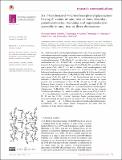Six 1-halobenzoyl-4-(2-methoxyphenyl)piperazines having Z' values of one, two or four; disorder, pseudosymmetry, twinning and supramolecular assembly in one, two or three dimensions
Abstract
Six 1-halobenzoyl-4-(2-methoxyphenyl)piperazines have been prepared using carbodiimide-mediated coupling reactions between halobenzoic acids and N-(2-methoxyphenyl)piperazine. The molecules of 1-(4-fluorobenzoyl)-4-(2-methoxyphenyl)piperazine, C18H19FN2O2 (I), are linked into a chain of rings by a combination of C-H···O and C-H···π(arene) hydrogen bonds. 1-(4-Chloro-benzoyl)-4-(2-methoxyphenyl)piperazine, C18H19ClN2O2 (II), crystallizes in the space group Pca21 with Z' = 4 and it exhibits both pseudosymmetry and inversion twinning: a combination of six C-Six 1-halobenzoyl-4-(2-methoxyphenyl)piperazines have been prepared using carbodiimide-mediated coupling reactions between halobenzoic acids and N-(2-methoxyphenyl)piperazine. The molecules of 1-(4-fluorobenzoyl)-4-(2-methoxyphenyl)piperazine, C18H19FN2O2 (I), are linked into a chain of rings by a combination of C—H⋯O and C—H⋯π(arene) hydrogen bonds. 1-(4-Chlorobenzoyl)-4-(2-methoxyphenyl)piperazine, C18H19ClN2O2 (II), crystallizes in the space group Pca21 with Z′ = 4 and it exhibits both pseudosymmetry and inversion twinning: a combination of six C—H⋯O and two C—H⋯π(arene) hydrogen bonds generate a three-dimensional assembly. In 1-(4-bromobenzoyl)-4-(2-methoxyphenyl)piperazine, C18H19BrN2O2 (III), which also crystallizes in space group Pca21 but with Z′ = 2, the bromobenzoyl unit in one of the molecules is disordered. Pseudosymmetry and inversion twinning are again present, and a combination of three C—H⋯O and one C—H⋯π(arene) hydrogen bonds generate a two-dimensional assembly. A single C—H⋯O hydrogen bond links the molecules of 1-(4-iodobenzoyl)-4-(2-methoxyphenyl)piperazine, C18H19IN2O2 (IV), into simple chains but in the isomeric 3-iodobenzoyl analogue (V), which crystallizes in space group P212121 with Z′ = 2, a two-dimensional assembly is generated by a combination of four C—H⋯O and two C—H⋯π(arene) hydrogen bonds; pseudosymmetry and inversion twinning are again present. A single C—H⋯O hydrogen bond links the molecules of 1-(2-fluorobenzoyl)-4-(2-methoxyphenyl)piperazine, C18H19FN2O2 (VI), into simple chains. Comparisons are made with the structures of some related compounds.H center dot center dot center dot O and two C-H center dot center dot center dot pi(arene) hydrogen bonds generate a three-dimensional assembly. In 1-(4-bromobenzoyl)4-(2-methoxyphenyl)piperazine, C18H19BrN2O2 (III), which also crystallizes in space group Pca2(1) but with Z' = 2, the bromobenzoyl unit in one of the molecules is disordered. Pseudosymmetry and inversion twinning are again present, and a combination of three C-H···O and one C-H···π(arene) hydrogen bonds generate a two-dimensional assembly. A single C-H···O hydrogen bond links the molecules of 1-(4-iodobenzoyl)-4-(2-methoxyphenyl)piperazine, C18H19IN2O2 (IV), into simple chains but in the isomeric 3-iodobenzoyl analogue (V), which crystallizes in space group P212121 with Z' = 2, a two-dimensional assembly is generated by a combination of four C-H··· O and two C-H ···π(arene) hydrogen bonds; pseudosymmetry and inversion twinning are again present. A single C-H ···O hydrogen bond links the molecules of 1-(2-fluorobenzoyl)-4-(2-methoxyphenyl)piperazine, C18H19FN2O2 (VI), into simple chains. Comparisons are made with the structures of some related compounds.
Citation
Chinthal , C H , Kavitha , C N , Yathirajan , H S , Foro , S & Glidewell , C 2021 , ' Six 1-halobenzoyl-4-(2-methoxyphenyl)piperazines having Z ' values of one, two or four; disorder, pseudosymmetry, twinning and supramolecular assembly in one, two or three dimensions ' , Acta Crystallographica Section E Crystallographic Communications , vol. 77 , no. 1 , pp. 5-13 . https://doi.org/10.1107/S2056989020015649
Publication
Acta Crystallographica Section E Crystallographic Communications
Status
Peer reviewed
ISSN
2056-9890Type
Journal article
Description
HSY thanks the University Grants Commission, New Delhi for the award of a BSR Faculty Fellowship for three years.Collections
Items in the St Andrews Research Repository are protected by copyright, with all rights reserved, unless otherwise indicated.

